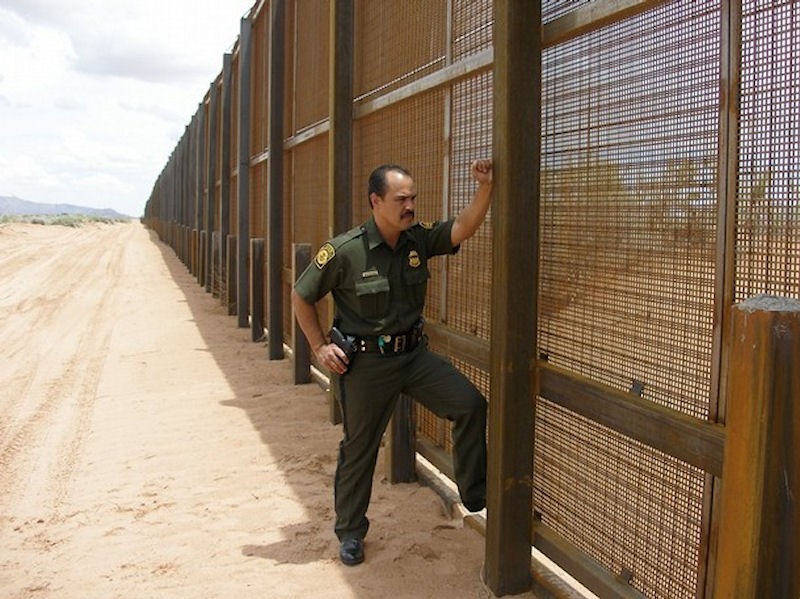
Ten years ago, the United States Congress passed H.R. 6061 authorizing construction of a 700-mile “wall” along our southern border with Mexico. Funding for the bill, which President George W. Bush signed into law on October 26, 2006, was not nearly enough (at $1.2 billion) to satiate our American wall fixation. Between 2007 and 2014, the government sunk another $5.2 billion into a Homeland Security account called Border Security Fencing, Infrastructure, and Technology.
Now, the leading, but receding, GOP candidate for president has campaigned vigorously on the promise of building a wall. When someone at Rhodes College anonymously chalked a sidewalk with the message “Trump 2016: Build a Wall,” many students were offended and dismayed. But “wall politics” have been with us for a while here in America, and walls, we know, never solve problems or bring about social peace. If you don’t believe us, ask the Israelis. Talk to some Berliners. Study the rationale and history behind the construction of China’s “Great Wall.”
Shouting at wall advocates is counter-productive. Thinking creatively about ways to engage those who truly believe in the benefits of border fences is a better strategy.
Most people in America are not mean-spirited, nativist know-nothings. But many are generally confused by an outdated, impossibly complex immigration system that can only be modernized through an act of Congress. Since this particular Congress takes the cake for fecklessness, fear, and inaction, it’s unlikely we’ll get authentic immigration reform any time soon. This means that the people with the biggest mouths, the deepest pockets, and the skills to manipulate the national media have taken control of the immigration issue. What to do? Here’s a game plan to prevent that foolish barrier:
First, register to vote, and work to elect a new Congress. It’s not impossible, but it won’t happen easily or quickly. It will take more than signing a passive, online petition. It will require much more time and energy than goes into posting a message or two on Facebook, Twitter, or Tumblr.
Second, study up. Good, careful articles dealing with the fence, the technological glitches, the politics and funding of the fence, and the negative international reaction have been published recently. It’s imperative to fight those who manipulate the fears of others with information, statistics, and historical analysis.
Immigrants — documented and undocumented alike — make our cities more vibrant; they provide invaluable labor and services to our economy; and they contribute billions of dollars in taxes and to social security. Unauthorized workers pay about $13 billion a year in social security and take out less than $1 billion. Over the past 10 years, they’ve paid $100 billion into that fund. In other words, the undocumented are helping to float our social security system.
Third, allow artistic expressions to animate your thinking on immigration. Focusing only on the soul-draining political details minimizes the time we have to read literature, watch films, and listen to music. Carlos Fuentes, Yuri Herrera, Ana Castillo, and Oscar Casares have all published works that help us see the debate in a distinct dimension — creatively, metaphorically.
Two important films — El Norte and The Three Burials of Melquiades Estrada — are worth watching to help humanize the issue. These stories add depth and beauty to a dispiriting, dour debate that’s increasingly playing out on social media rather than face-to-face. We don’t debate anymore; we argue on Facebook, using a medium where we choose our friends and stare into a computer screen rather than into a person’s eyes.
Finally, any of you remember Lou Dobbs? We’ve forgotten about him, too. Dobbs was a CNN media star for many years and focused his nightly reports on the dangers of immigration. He carefully selected, collected, and reported the crimes and other deprivations committed by immigrants. It worked for a while, but, by 2009, people grew tired of his campaign, his ratings fell, and he was pushed out. Musician/activist Steve Earle concluded the liner notes to his 2007 album Washington Square Serenade with the memorable “P.S. F—k Lou Dobbs,” an addendum that sort of sums up that unfortunate era.
Let’s take back the immigration debate and force Congress to act. Let’s stand up to those wishing for a wall not with lachrymose-laden laments but with real action predicated upon study and preparation. If we hope to retain our nation’s bedrock values, we’ll have to engage the wall advocates in this war of ideas and ideals. Retreating out of fear or behind dismissive labels is not the answer, and if the wall actually gets built, we’ll have only ourselves to blame.
Bryce Ashby is a Memphis-based attorney and board chair at Latino Memphis; Michael J. LaRosa is an associate professor of history at Rhodes College.